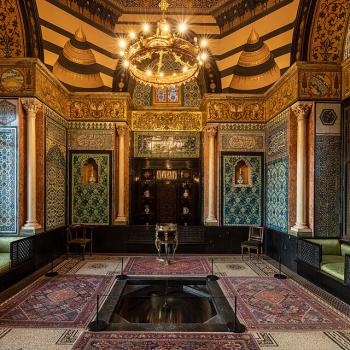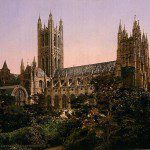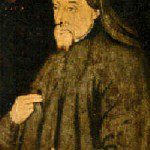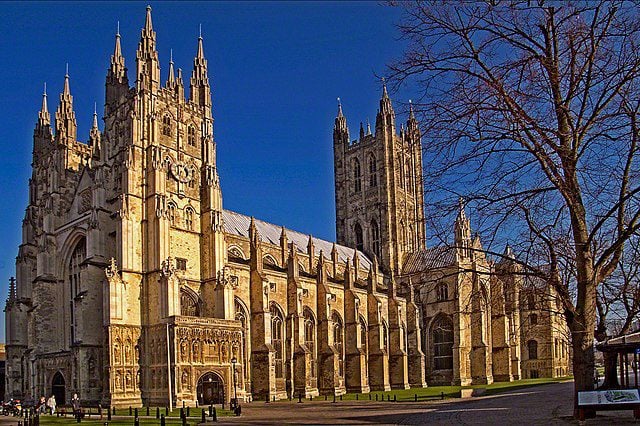
We landed very early this morning at Dover, with a clear view from the decks of the docked ship of both Dover Castle and the area’s famous white cliffs. But we actually spent the day walking around Canterbury, the heart of historic English Christianity, which is located fairly closely nearby. Peter Fagg, the Latter-day Saint tour guide who took us about Liverpool and the Ribble Valley area on Saturday, met us in Dover and led us around Canterbury, where he was born.
We first visited the ancient Church of St. Martin, which is generally acknowledged to be the oldest church building in Britain that is still in use as a church and which may, in fact, be the oldest parish church in the entire English-speaking world. (A sign at the entrance to the churchyard isn’t alone in identifying it as such.) St. Martin’s was the private chapel of Queen Bertha of Kent (d. ca AD 601), a Christian Frankish princess who come to England as the bride of a pagan husband, King Æthelberht of Kent, who had accommodated her faith by renovating a Roman-British building for her use in about AD 580. He and ten thousand of his people eventually accepted Christianity. Along with Canterbury Cathedral itself and St. Augustine’s Abbey (which we walked by shortly thereafter), St. Martin’s has been designated a UNESCO World Heritage Site.
Parenthetically, I note that Bro. Fagg’s father was christened at St. Martin’s and that his parents were also married in that ancient church. Some time later, they met missionaries from the Church of Jesus Christ of Latter-day Saints and accepted the Restored Gospel. They eventually presided over the London England Temple from 2007 to 2010.
We walked, as I say, a very great deal around the oldest parts of Canterbury. Along a portion of the city wall, down several old streets, into and about a couple of old churches, and so forth. We had a good and exceedingly English lunch, too, at The Old Weavers Restaurant, which is located in a building that, despite the date of AD 1500 that’s given on its façade, was probably originally constructed sometime in the fourteenth century. When Flemish and Huguenot weavers settled in the area after fleeing religious persecution during the sixteenth and seventeenth centuries. Queen Elizabeth I granted them the right to establish their businesses in Canterbury, and they are known to have used this particular building and other similar buildings in the immediate vicinity. Hence the name of the restaurant.
But the main object of our attention, I suppose (certainly it was my chief focus), was Canterbury Cathedral — or, to give it its official title, the Cathedral and Metropolitical Church of Christ at Canterbury. A cathedral is, of course, not merely or even necessarily a large church. Rather, by definition, it is the home church, the seat (cathedra), of a bishop. In this particular case, Canterbury Cathedral is the seat of the Archbishop of Canterbury, who is not only the leader of the Church of England but the symbolic leader of the entire Anglican communion, worldwide — including the Episcopalian church in the United States.
Canterbury Cathedral was founded in AD 597 by St. Augustine — not the great Latin Church Father St. Augustine of Hippo, but St. Augustine of Canterbury, who is, in his own way, also exceedingly important.
I think it fair to say that the Cathedral is most famous, apart from the sheer fact that it’s the mother church of worldwide Anglican Christianity, which is no small thing, for its association with St. Thomas Becket. Formerly the Lord Chancellor of England who had been appointed archbishop by his then good friend King Henry II, he resisted royal encroachments upon ecclesiastical privileges. The frequent conflicts between Thomas and Henry allegedly led the king to exclaim, one day, “Will no one rid me of this turbulent priest?” (A more accurate English version of what Henry originally said in Latin may go as follows: “What miserable drones and traitors have I nourished and brought up in my household, who let their lord be treated with such shameful contempt by a low-born cleric?”) Four of his knights — Reginald FitzUrse, Hugh de Morville, William de Tracy and Richard le Breton — took the cue (or, if you prefer, completely misread Henry’s intentions) and, on Tuesday, 29 December 1170, they savagely and brutally murdered the archbishop in his own cathedral. Very soon thereafter, miracles began to be ascribed to him and he was canonized as St. Thomas Becket. King Henry was obliged to do penance, and pilgrims began to surge toward Canterbury in greater numbers than they ever had before.
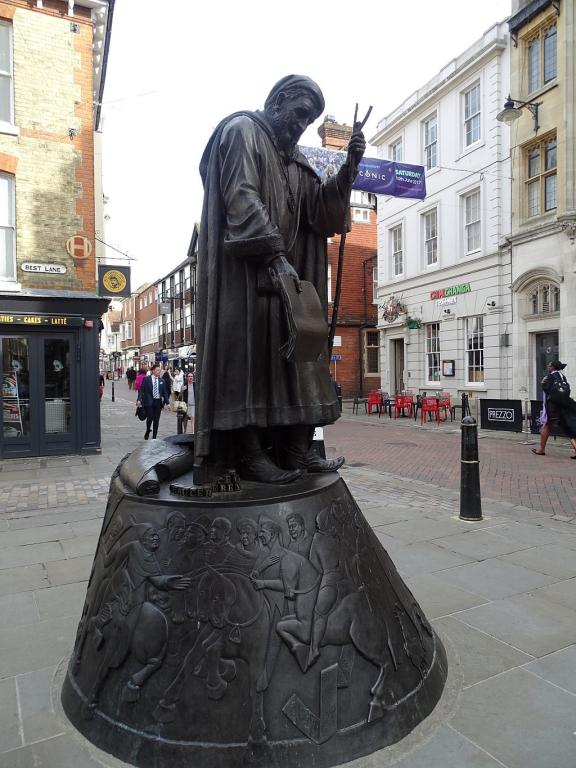
Near The Old Weavers’ Restaurant stands a modern statue of the poet Geoffrey Chaucer (1343-1400), whose Canterbury Tales represent one of the earliest classics of English literature and remain among its greatest creations. This is how the collection starts:
In Evan Mantyk’s modern translation, this is how the lines above read:
When April’s sweetest showers downward shoot,
The drought of March is pierced right to the root
Through every vein with liquid of such power
And virtue that it generates the flower;
When Zephyrus too exhales his breath so sweet
Inspiring in ground beneath the feet
The tender crops, and there’s a youthful sun,
His second half course through the Ram now run,
And little birds start making melodies
Who sleep all night eyes open in the trees
(For Nature pricks them in each little heart),
On pilgrimage then folks desire to start.
The palmers seek to make their travel plans
For far-off shrines renowned in sundry lands.
Especially from every English town
To Canterbury now their steps are bound,
To seek the holy blissful martyr quick
Who helped them out when once they had been sick.
To get myself into the vein for visiting Canterbury Cathedral, I had too little time to re-read Chaucer. But I did re-read T. S. Eliot’s 1935 verse drama Murder in the Cathedral, which deeply impressed me when I first read it in high school, and my wife and I watched the 1964 film Becket, which stars Peter O’Toole as King Henry II and Richard Burton as the Archbishop of Canterbury.
In the mid-sixteenth century, the ever-lovable King Henry VIII dissolved the Catholic monasteries of England and confiscated their wealth. During the same destructive period, he demolished the shrine of St. Thomas Becket in the cathedral and smashed Becket’s remaining bones to powder. (Have I ever mentioned that I dislike Henry VIII on virtually every level?) But three other locations in Canterbury Cathedral capture my interest:
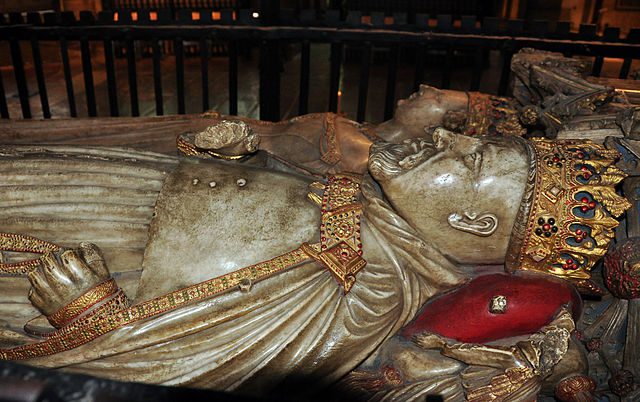
(Wikimedia Commons public domain image)
(1) The tomb of King Henry IV (1367-1413), so familiar from Shakespeare’s historical plays. He apparently wanted very much to be associated with St. Thomas Becket, and so chose burial at Canterbury over interment at Westminster Abbey.
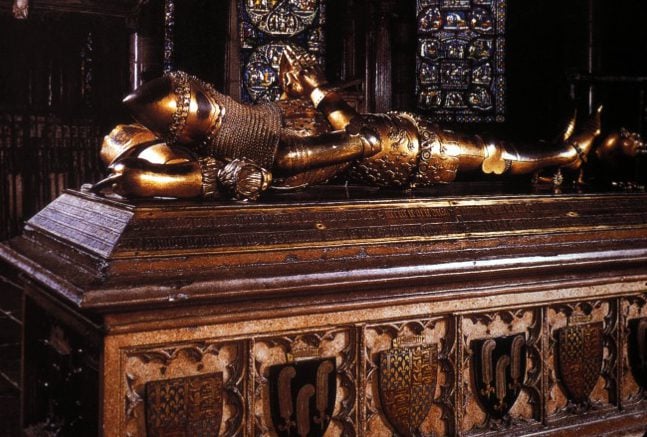
(2) The tomb of Edward the Black Prince (1330-1376), hero of the Battle of Crécy, one of the most successful English commanders during the Hundred Years’ War, widely considered by his peers as a model of chivalry and knighthood. He was the eldest son of King Edward III of England and, until his premature death, the heir apparent to the English monarchy. His own son, Richard II, succeeded to the throne in his stead. The effigy on his tomb is quite impressive, and this inscription appears on it:
Such as thou art, sometime was I.
Such as I am, such shalt thou be.
I thought little on th’our of Death
So long as I enjoyed breath.
On earth I had great riches
Land, houses, great treasure, horses, money and gold.
But now a wretched captive am I,
Deep in the ground, lo here I lie.
My beauty great, is all quite gone,
My flesh is wasted to the bone.
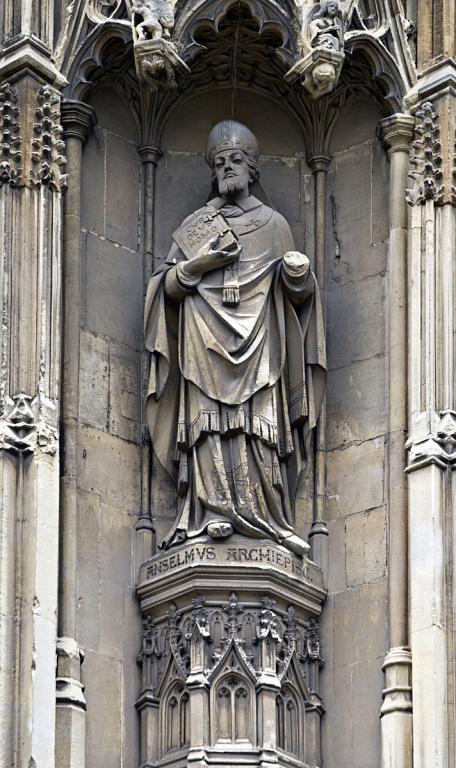
(Wikimedia Commons public domain image)
(3) The chapel, at least, of St. Anselm of Canterbury (1033/4-1109) — archbishop, theologian, and philosopher, sometimes considered the greatest Christian thinker between St. Augustine of Hippo (AD 354-430) and St. Thomas Aquinas (AD 1225-1274). He is the originator of the so-called “ontological argument” for the existence of God, and he is an official “doctor” of the Roman Catholic Church. The exact location of his remains is unknown; his shrine was probably destroyed and his bones pulverized under Henry VIII.
Posted from the English Channel



